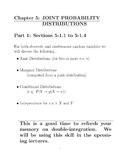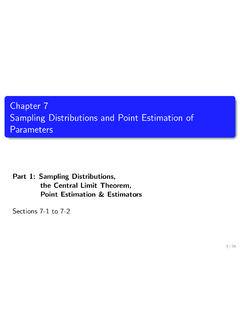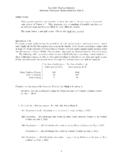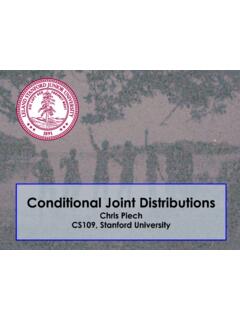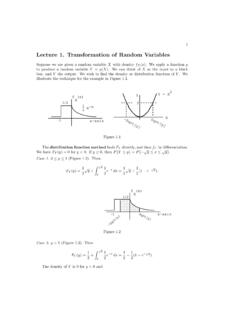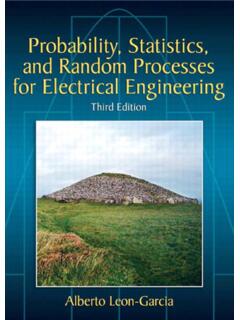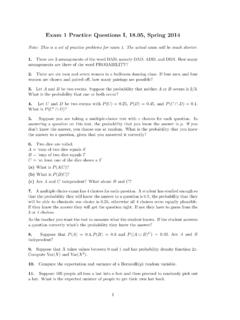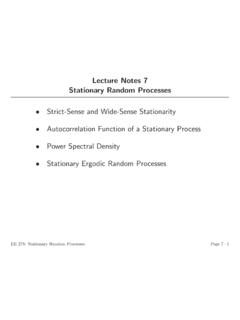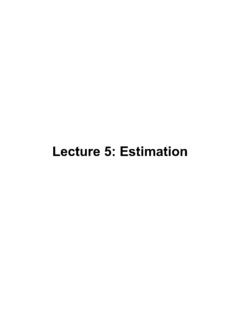Transcription of Chapter 5: JOINT PROBABILITY DISTRIBUTIONS Part 3: The ...
1 Chapter 5: JOINT PROBABILITYDISTRIBUTIONSPart 3:The Bivariate NormalSection Functions of Random VariablesSection 5-41 The bivariate normal is kind of nifty The marginal DISTRIBUTIONS ofXandYareboth univariate normal DISTRIBUTIONS . The conditional distribution ofYgivenXisa normal distribution . The conditional distribution ofXgivenYisa normal distribution . Linear combinations ofXandY(such asZ= 2X+ 4Y) follow a normal distribution . It s normal almost any way you slice Bivariate Normal ProbabilityDensity FunctionThe parameters: X, Y, X, Y, fXY(x,y) =12 X Y (1 2) exp{ 12(1 2)[(x X)2 2X 2 (x X)(y Y) X Y+(y Y)2 2Y]}for < x < and < y < , withparameters X>0 , Y>0 , < X< , < Y< ,and 1< < is the correlation other parameters are the needed parame-ters for the marginal DISTRIBUTIONS Bivariate NormalWhenXandYareindependent, the con-tour plot of the JOINT distribution looks like con-centric circles (or ellipses, if they have differentvariances) with major/minor axes that are par-allel/perpendicular to thex-axis:The center of each circle or ellipse is at ( X, Y).
2 4 Bivariate NormalWhenXandYaredependent, the contourplot of the JOINT distribution looks like concen-tric diagonal ellipses, or concentric ellipses withmajor/minor axes that are NOT parallel/perp-endicular to thex-axis:The center of each ellipse is at ( X, Y).5 Marginal DISTRIBUTIONS ofXandYinthe Bivariate NormalMarginal DISTRIBUTIONS ofXandYare nor-mal:X N( X, 2X) andY N( Y, 2Y)Know how to take the parameters from thebivariate normal and calculate probabilitiesin a univariateXorYproblem. Conditional distribution ofY|xin theBivariate NormalThe conditional distribution ofY|xis alsonormal:Y|x N( Y|x, 2Y|x)6Y|x N( Y|x, 2Y|x)where the mean ofY|x or Y|xdependson the givenx-value as Y|x= Y+ Y X(x X)and variance ofY|x or 2Y|xdepends onthe correlation as 2Y|x= 2Y(1 2).Know how to take the parameters from thebivariate normal and get a conditional distri-bution for a givenx-value, and then calculateprobabilities for the conditional distributionofY|x(which is a univariate distribution ).
3 Remember that probabilities in the normalcase will be found using what happens to the JOINT distribution (and conditional) as gets closer to +1: = = = a last note on the bivariate = 0 does not meanXandYare in-dependent in all cases, for the bivariate normal,this does the Bivariate Normal,Zero Correlation Implies IndependenceIfXandYhave a bivariate normal distribution (so, we know the shape of the JOINT distribution ),then with = 0, we haveXandYas Example: From book problem a bivariate normaldistribution X= 120, X= 5 Y= 100, Y= 2 = :(i) Marginal PROBABILITY distribution ofX.(ii) Conditional PROBABILITY distribution ofYgiven thatX= Functions of Random VariablesSection 5-4 Linear CombinationGiven random variablesX1,X2,..,Xpandconstantsc1,c2,.. ,cp,Y=c1X1+c2X2+ +cpXpis a linear combinationofX1,X2,..,Xp. Mean of a Linear FunctionIfY=c1X1+c2X2+ +cpXp,E(Y) =c1E(X1)+c2E(X2)+ +cpE(Xp)11 Variance of a Linear FunctionIfX1,X2.
4 ,Xpare random variables, andY=c1X1+c2X2+ +cpXp, thenin generalV(Y) =c21V(X1)+c22V(X2) + +c2pV(Xp)+ 2 i<j cicjcov(Xi,Xj)In this class, all our linear combinations ofrandom variables will be done with indepen-dent random ,X2,..,Xpare independent,V(Y) =c21V(X1)+c22V(X2)+ +c2pV(Xp)The most common mistake for finding thevariance of a linear combination is to forgetto square the Example: Semiconductor product (exam-ple 5-31)A semiconductor product consists of threelayers. The variance of the thickness of thefirst, second, third layers are 25, 40, and is the variance of the thickness of thefinal product?ANS:13 Mean and Variance of an AverageIf X=(X1+X2+ +Xp)pwithE(Xi) = fori= 1,2,..,pthenE( X) = .The expected value of the average ofpran-dom variables, all with the same mean ,is just ,X2,..,Xpare also independentwithV(Xi) = 2fori= 1,2.
5 ,pthenV( X) = 2pThe variance of the average ofprandomvariables is smaller than the variance of asingle random Reproductive Property of theNormal DistributionIfX1,X2,..,Xpare independent, normalrandom variableswithE(Xi) = iandV(Xi) = 2ifori= 1,2,..,p,Y=c1X1+c2X2+ +cpXpis a normal random variable with Y=E(Y) =c1 1+c2 2+ +cp pand 2Y=V(Y) =c21 21+c22 22+ +c2p N( Y, 2Y) as described linear combination of normal s is also Example: Weights of peopleAssume that the weights of individuals areindependent and normally distributed witha mean of 160 pounds and a standard devi-ation of 30 pounds. Suppose that 25 peoplesqueeze into an elevator that is designed tohold 4300 ) What is the PROBABILITY that the load ex-ceeds the design limit?1617
